Showing 1–12 of 17 results
-
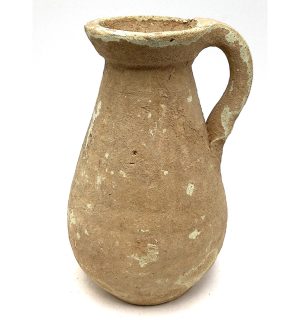
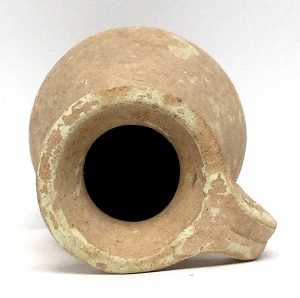
$275.00
H: 4.5” W: 3” D: 2.75” | FREE SHIPPING WITHIN CONTINENTAL U.S. !
Small wine jugs were made in the Roman North Africa territory called Africa Proconsulares and exported throughout the empire. Made and decorated with ribbing and a single handle on a potters wheel it was fired in a kiln. Simple and unadorned functional objects called coarse wears were made everyday use and to make offerings to deities using inexpensive long-lasting materials. Very good example of pouring vessels from ancient history throughout the Roman Empire.
-
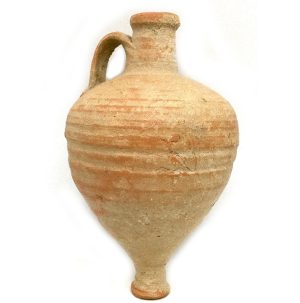
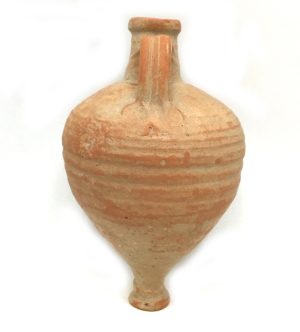
$425.00
H: 5.75” W: 3.375” | FREE SHIPPING!
An amphora is Greek jar with a single or double handles made in a variety of sizes and copied by all ancient Mediterranean trading nations. This amphoriskos, literally a “small amphora,” has a stunning profile and one handle but is top heavy and cannot stand without support. It dates from the time of the Holy Land during the first Jewish Biblical Period in Judea circa the 8th to 6th century BCE, a ancient time from which few pieces survive intact.
-
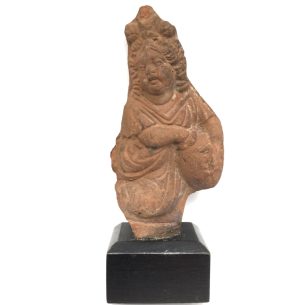
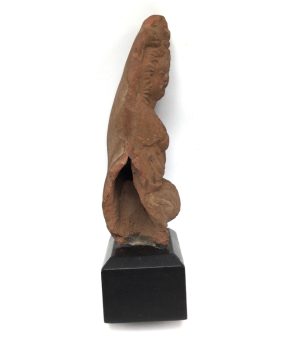
$395.00
Ht: 6.5” W: 2.625” D: 1.75” | FREE SHIPPING!
This figure is Harpocrates the Greek god of silence, confidentiality and secrets holding a jar and was made using a bivalve-mould. The iconography hints at a royal and temple cult, as he wears a double crown symbolizing both Upper and Lower Egypt. A royal emblem showing an association with the contemporary king, in Egypt royals with crowns were a manifestation of the Egyptian god Horus. Small white specks are all that remains of the slip and colorful paints covering it. Missing part of his right side when excavated, there are no repairs and it is mounted on a stand. Given its age, the image is in good condition with normal scrapes and cracks found in pieces of this age.
-
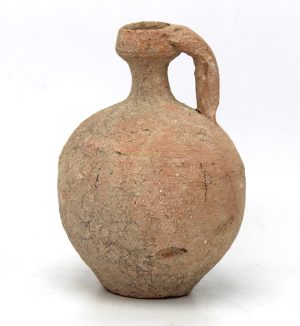
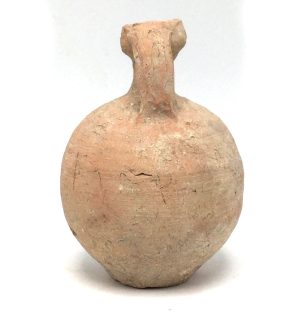
$395.00
H: 4” Dia: 2.75″ | FREE SHIPPING!
This pottery Judean juglet was made during the Biblical Period in the Holy Land and used to hold perfume or other costly items. Its upper body tapers inward to a narrow neck to limit its pouring rate and conserve its contents. Covered with slip to lessen leakage and improve their appearance, these were used throughout the Roman Empire.
-
Sale!
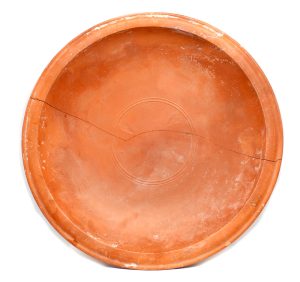
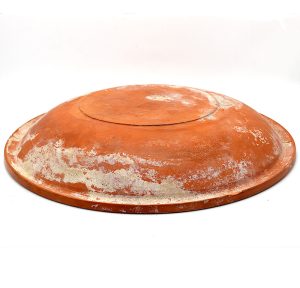
$485.00 Original price was: $485.00.$395.00Current price is: $395.00.
H: 2.25” Dia: 14.5″ | made in Africa Proconsularis, the Roman North Africa pottery center and distributed throughout the Roman Empire).
Created in the Roman North Africa territory named Africa Proconsularis, platters like this were distributed throughout the Roman Empire. it is a remarkable piece known as ARS (African Red Slip) that is decorated with circular rings with perfect ridges made using a pottery wheel. This ancient serving plate is remarkable for its survival, size, stamped designs and graceful simplicity. Found in two pieces, the breaks were clean and glued together. Platters of this size are rare and are usually in multiple broken pieces with significant losses.
-
Sale!

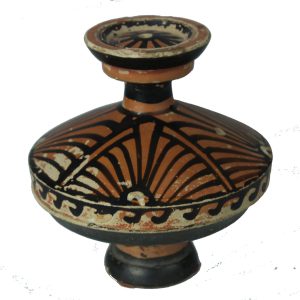
$595.00 Original price was: $595.00.$525.00Current price is: $525.00.
H: 3.625” Dia: 3.5″ | FREE SHIPPING within contiNental U.S.!
This diminutive but very elegant piece is a lekanis, a lid-covered container for cosmetics. Originating in Greece embraced by artisans from Apulia in Magna Graecia in Southern Italy who adapted this form in their Xenon wares in the 6th century B.C.E. This terracotta lidded bowl is covered with pale matte salmon decorations over a black glazed body highlighted with decorative meandering bands. Fathers in ancient times filled these bowls with small items of adornment and gave them to their daughters as a wedding gift, which would be a delightful tradition to uphold today.
container for cosmetics in the 6th century BCE.and a matte pale orange-red or salmon decoration over a black glazed terracotta body fired from red clay. It was used as a special gift for a bride from fathers with small adornment items placed inside.
-
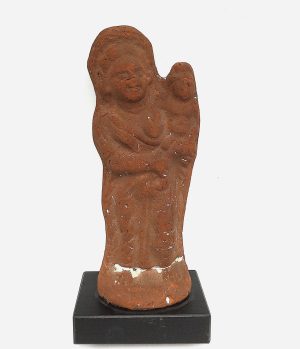
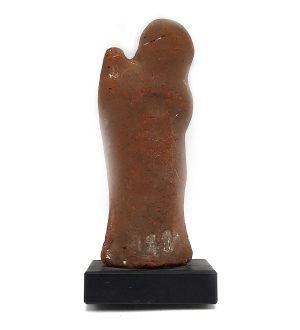
$395.00
Ht: 6.75” W: 3” D: 2” | FREE SHIPPING!
This Roman Egyptian figurine from Alexandria of a woman holding a young child is a Kourotrophos, a class of god and goddess figures holding infants or children. Referred to as child nurturers, these were revered deities, cult figures and mortals who were also fertility symbols and protectors of the young. Mother and child figures like this are universal and appear known in disparate cultures throughout the world.
-
Sale!
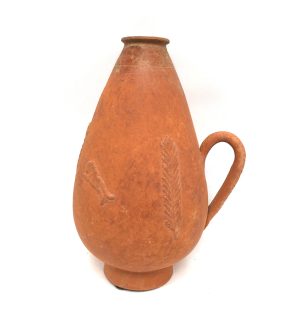
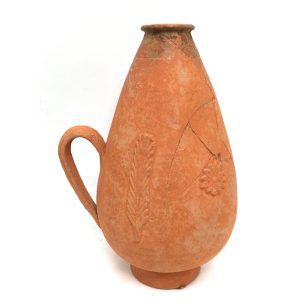
$525.00 Original price was: $525.00.$425.00Current price is: $425.00.
Ht: 7” W: 4.875” D: 4” | FREE SHIPPING within Continental U.S.!
This thin-walled ancient Roman vessel is a beautiful work of art. Its has a delicate piriform (pear-shaped) body and fine relief designs of a rosette, lion and palm leaves surround it.
-
Sale!
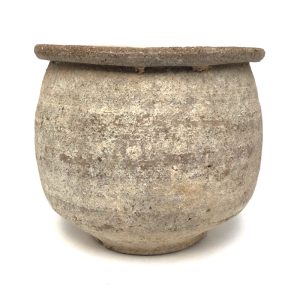
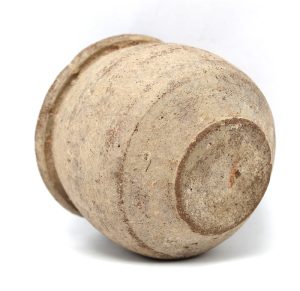
$325.00 Original price was: $325.00.$295.00Current price is: $295.00.
H: 2.675” DIA: 3” | FREE SHIPPING WITHIN CONTINENTAL U.S.!
This simple ancient small earthenware bowl was made in Africa Proconsularis, the Roman North Africa pottery center and distributed throughout the Roman Empire. With no handle, this beaker is beautiful in its simplicity resting on a short foot, a body that curves up and rises to meet a neck and is topped with an everted rim to lessen spillage Made for daily use, this Roman coarse wear has a wide mouth for easy drinking and a rim with light terracotta red and its crème slip with an exquisite shape.
-
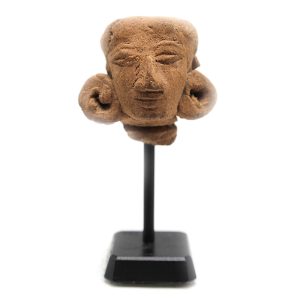
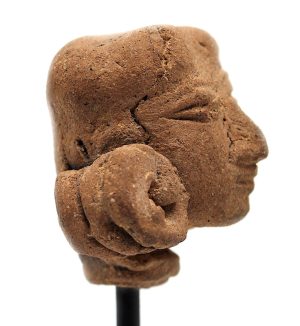
$195.00
Ht: 2.75” W: 1.375” D: 1.125” | FREE SHIPPING!
This terracotta head was crafted during the Majapahit Empire in Java and was either part of a bas-relief frieze or made as a freestanding figurine. Most figures found are small decapitated heads with no bodies, and it is very rare to find a complete figure with a naturalistic facial expression. As with many heads, this one displays Javanese facial features, hairstyles and ear ornamentation typical of the period. It has a naturalistic facial expression and wears large round coiled earrings, possibly suggesting it represented someone of the upper classes. It is in very good condition given its age and use and is mounted on a metal stand. This item pairs with Majapahit Miniature Terracotta 1138.
-
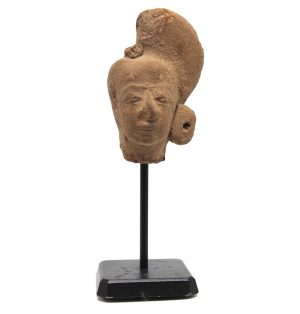
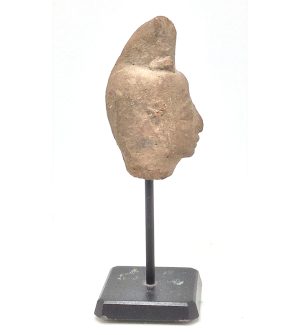
$195.00
Ht: 4” W: 1.5” D: 1.75” | FREE SHIPPING!
This terracotta head was crafted during the Majapahit Empire in Java and was either part of a Hindu bas-relief frieze or made as a freestanding figurine. Most figures found are small decapitated heads with no bodies, and it is very rare to find a complete figure with a naturalistic facial expression. As with many heads, this one displays Javanese facial features, hairstyles and ear ornamentation typical of the period. It has a naturalistic facial expression and wears large round coiled earrings, possibly suggesting it represented someone of the upper classes. It is in very good condition given its age and use and is mounted on a metal stand. This items pairs with Majapahit Terracotta Head 1137.
-
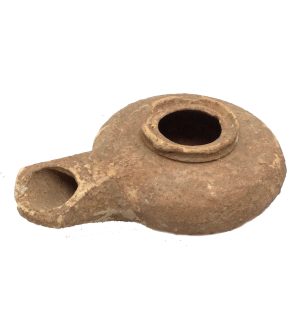
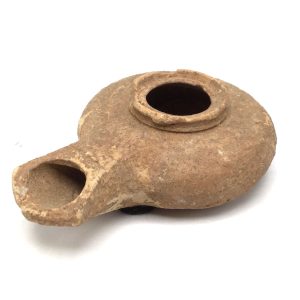
$155.00
SOLD
This Roman catacomb terracotta oil lamp is a basic, undecorated, and functional lamp beautiful in its simplicity. It is a well moulded piece with a finely rounded circular body, a short raised rim surrounding the fill hole centered in the middle, and has a hand made spatulate nozzle added to its body. The nozzle extends out with flat angular ridges and a wide opening to accommodate the wick which extends from inside the lamp,through the nozzle, and then reaches over its edge. It has no handle but, like all such lamps, it has a flat bottom to rest comfortably and securely on any surface. Much of the original crème slip on this lamp remains and has turned a brownish-beige from the soil in which it was buried underground. There are minor chips the rim atop the fuel chamber and projecting nozzle and is otherwise is very good condition.
End of content
End of content
























